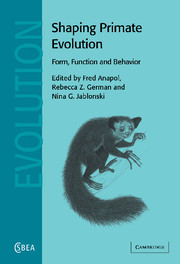Book contents
- Frontmatter
- Contents
- List of contributors
- Preface: shaping primate evolution
- 1 Charles Oxnard: an appreciation
- Part I Craniofacial form and variation
- Part II Organ structure, function, and behavior
- 6 Fiber architecture, muscle function, and behavior: gluteal and hamstring muscles of semiterrestrial and arboreal guenons
- 7 Comparative fiber-type composition and size in the antigravity muscles of primate limbs
- 8 On the nature of morphology: selected canonical variates analyses of the hominoid hindtarsus and their interpretation
- 9 Plant mechanics and primate dental adaptations: an overview
- 10 Convergent evolution in brain “shape” and locomotion in primates
- Part III In vivo organismal verification of functional models
- Part IV Theoretical models in evolutionary morphology
- Part V Primate diversity and evolution
- Index
- References
9 - Plant mechanics and primate dental adaptations: an overview
Published online by Cambridge University Press: 10 August 2009
- Frontmatter
- Contents
- List of contributors
- Preface: shaping primate evolution
- 1 Charles Oxnard: an appreciation
- Part I Craniofacial form and variation
- Part II Organ structure, function, and behavior
- 6 Fiber architecture, muscle function, and behavior: gluteal and hamstring muscles of semiterrestrial and arboreal guenons
- 7 Comparative fiber-type composition and size in the antigravity muscles of primate limbs
- 8 On the nature of morphology: selected canonical variates analyses of the hominoid hindtarsus and their interpretation
- 9 Plant mechanics and primate dental adaptations: an overview
- 10 Convergent evolution in brain “shape” and locomotion in primates
- Part III In vivo organismal verification of functional models
- Part IV Theoretical models in evolutionary morphology
- Part V Primate diversity and evolution
- Index
- References
Summary
Introduction
Most mammals chew their food, a process generally involving the fracture and fragmentation of food particles. The efficiency of this process can be measured by the rate at which food particle size is reduced per chew and depends on the match of postcanine tooth shape to the mechanical properties of the food. The dentition of a mammal is presumably adapted to its diet so as to produce a rate of processing in the mouth sufficient for the gut to service its metabolic rate. Previously, I have offered very generalized models for the differentiation of molar shape in relation to food type (Lucas, 1979). The aim of this chapter is to suggest gains in understanding of tooth form that follow from more detailed analysis of food properties. The arguments presented here are snippets of those to be published in a forthcoming book (Lucas, in press).
For the dentition of a primate to be optimally adapted to its diet, the animal must either feed on a very restricted range of foods, with consequently limited variation in mechanical texture, or else actively select foods on a textural basis. It is difficult, at first glance, to imagine that primates employ the texture of plant parts as a primary criterion for food selection. Species that forage widely, eating many plant species, are more likely to use long-range senses like color and smell as primary sensory cues to draw them towards potential foods, or else they would waste much time in moving around to sample food texture with their forelimbs or mouth.
- Type
- Chapter
- Information
- Shaping Primate EvolutionForm, Function, and Behavior, pp. 193 - 205Publisher: Cambridge University PressPrint publication year: 2004
References
- 2
- Cited by



